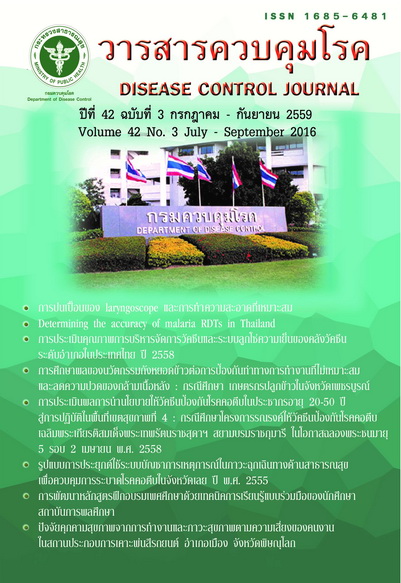Evaluation of the diphtheria vaccination campaign among people aged 20-50 years in the Health Region 4, on the occasion of Her Royal Highness (HRH) Princess Maha Chakri Sirindhorn’s 5th Birthday Cycle on 2nd April, 2015: moving from policy to practice
DOI:
https://doi.org/10.14456/dcj.2016.15Keywords:
policy, practice, diphtheria vaccine, adults age 20-50 yearsAbstract
The purpose of this study was to evaluate the process and success in translation of policy on the 2015 diphtheria vaccination campaign among people aged 20-50 years in the Health Region 4 into practice. We conducted a descriptive study using the analysis framework for public policy. Two groups of population were selected. (1) 81 responsible campaign staffs at provincial, district and sub-district level from 5 prov¬inces, namely Saraburi, Lopburi, Singburi, Nakornnayok and Angthong (2) 500 villagers in the same areas as above. One time data collection using questionnaire, interview, and data review was done during June and July 2015. Data was analyzed using percentage and mean. In process evaluation, the study demonstrated as followed. (1) The policy objective was clear. It was to increase the immunity level against diphtheria in the community among people aged 20-50 years (who were born before the starting of the National Immunization Program). The target coverage was set at 85.0%. (2) For political support, the campaign was endorsed and funded by the government. (3) The implementing units were clearly identified. The campaign was responsi¬ble by the Ministry of Public Health. The Department of Disease Control was the main coordinating unit, responsible for moving the policy into practice at the province, district and sub-district levels. However, the campaign announcement was too close to the campaign periods, as a result, preparation time was too limited for the service units. (4) For policy communication, 85.2% of our samples perceived it as in the average to good level. (5) For logistic and resource support, manpower and resources such as budget, public commu¬nication material etc. were inadequate. (6) For service process, only 24.8% performed outreach activities. As a result, the reported vaccine coverage was 69.1% not reached the 85% target. In outcome evaluation (success), among the sampled villagers, 65.6% received vaccination. The coverage was below the 85% target. 66.1% reported pain, swelling, redness at the site of injection. Only 68.0% understood that “without vaccination, one could contact diphtheria from foreign workers” Nonetheless, 99.2% said they were satisfied with this campaign. In conclusion, the good performing components found in this policy translation were clear objective, political support, and policy communication. The components that needed improvement included: process of work among implementing units, logistic and resource supports, and service process. The campaign fails to reach its vaccine coverage target. We recommended the following improvement on policy issues. (1) Allocate enough time for preparation, so each implementing units had time for planning and resources allo¬cation. (2) Increase mass media activities. It can raise awareness on nation-wide campaign activities both among staffs and villagers. (3) Campaign time should be short .We recommended the following improvement on practical issues. (1) In service planning, take into account the villager’s daily schedule. (2) Seek coop¬eration with the workplace managers, since the target group is working age people. (3) Increase monitoring activities to sustain campaign awareness at high level. (4) To increase and sustain confidence of villagers, improve quality of service e.g. Injection techniques and informed villagers of the usefulness of vaccine as well as the possible adverse reactions
Downloads
References
2. สถาบันวัคซีนแห่งชาติ กรมควบคุมโรค กระทรวงสาธารณสุข. หลักสูตรเชิงปฏิบัติการสำหรับเจ้าหน้าที่สร้างเสริมภูมิคุ้มกันโรค. กรุงเทพมหานคร: บริษัท สหมิตร พริ้นแอนด์พับลิสซิ่ง จำกัด; 2554.
3. กลุ่มโรคติดต่อที่ป้องกันได้ด้วยวัคซีน กรมควบคุมโรค. แนวทางการรณรงค์การให้วัคซีนคอตีบ-บาดทะยักแก่ประชาชนอายุ 20-50 ปี ในภาคเหนือ ภาคกลาง และภาคใต้. นนทบุรี: กลุ่มโรคติดต่อที่ป้องกันได้ด้วยวัคซีน กรมควบคุมโรค; 2558.
4. เรืองวิทย์ เกษสุวรรณ. การประเมินผลนโยบายสาธารณะ. กรุงเทพมหานคร: บริษัท บพิธการพิมพ์ จำกัด; 2555.
5. ธงชัย สันติวงษ์. องค์การและการบริหาร. กรุงเทพมหานคร: ไทยวัฒนาพานิช; 2543.
6. ประทวน สัตย์ซื่อ. ประสิทธิผลการปฏิบัติงานสร้างเสริมภูมิคุ้มกันโรคในเด็กอายุ 0-5 ปี ของเจ้าหน้าที่สาธารณสุขระดับตำบล จังหวัดกาญจนบุรี [วิทยานิพนธ์ ปริญญาวิทยาศาสตรมหาบัณฑิต] กรุงเทพมหานคร: มหาวิทยาลัยมหิดล; 2542.
7. ทองใบ สุดชารี. การนำนโยบายของวิทยาลัยครูไปปฏิบัติตาม : กรณีศึกษาสหวิทยาลัยอีสานใต้ [วิทยานิพนธ์ปริญญาพัฒนบริหารศาสตรดุษฏีบัณฑิต]. สถาบันบัณฑิตพัฒนบริหารศาสตร์; 2536.
8. สำนักโรคติดต่อทั่วไป กรมควบคุมโรค กระทรวงสาธารณสุข. คู่มือการเฝ้าระวังและสอบสวนอาการภายหลังได้รับวัคซีน. กรุงเทพมหานคร: สำนักงานกิจการโรงพิมพ์ องค์การสงเคราะห์ทหารผ่านศึก; 2550.
Downloads
Published
How to Cite
Issue
Section
License
Articles published in the Disease Control Journal are considered as academic work, research or analysis of the personal opinion of the authors, not the opinion of the Thailand Department of Disease Control or editorial team. The authors must be responsible for their articles.






